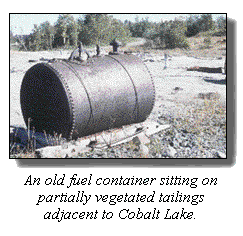There exist several distinctive infraspecific phenotypes within the arcellacean populations of Crosswise and Peterson lakes. Such phenotypes have developed in response to different environmental stresses, such as the presence of chemical pollutants in the substrate and low oxygen levels. The purpose of this research is to increase our understanding of arcellaceans as environmental and pollution indicators.
 Crosswise Lake has an area of approximately 3.2 square kilometres and has an elongate shape in a north-south direction. Tailings from five different mines were dumped into the northern portion of Crosswise Lake from 1905 to 1993. This dumping both shortened the lake by about 300 metres and shallowed its depth from 30-40 metres to 6-7 metres. Consequently, this artificial infilling has resulted in a lake with a very flat bottom with no thermocline. The pH ranges from 7.6 to 8.4 and oxygen solubility is 11.0 ppm at the surface and 8.0 ppm at the bottom.
Crosswise Lake has an area of approximately 3.2 square kilometres and has an elongate shape in a north-south direction. Tailings from five different mines were dumped into the northern portion of Crosswise Lake from 1905 to 1993. This dumping both shortened the lake by about 300 metres and shallowed its depth from 30-40 metres to 6-7 metres. Consequently, this artificial infilling has resulted in a lake with a very flat bottom with no thermocline. The pH ranges from 7.6 to 8.4 and oxygen solubility is 11.0 ppm at the surface and 8.0 ppm at the bottom. Peterson Lake is divided in two, an eastern and western portion, by a dam. Like Crosswise Lake, the eastern portion of Peterson Lake has been filled with tailings giving it a flat bottom. In 1965, the eastern portion of Peterson Lake was drained to remove mine waste. Unfortunately, the removal of about 55 000 tonnes disturbed the tailings that had already settled, destabilizing pollutants locked into the substrate exacerbating the effects of the pollution. In contrast to Crosswise lake, the larger western portion of Peterson Lake (2.3 square kilometres) has a thermocline at about 8 metres' depth and three distinct bathymetric areas: 1) a shallow weed-filled southern end; 2) a small shallow bay near the dam and; 3) a deep basin in the middle.
Peterson Lake is divided in two, an eastern and western portion, by a dam. Like Crosswise Lake, the eastern portion of Peterson Lake has been filled with tailings giving it a flat bottom. In 1965, the eastern portion of Peterson Lake was drained to remove mine waste. Unfortunately, the removal of about 55 000 tonnes disturbed the tailings that had already settled, destabilizing pollutants locked into the substrate exacerbating the effects of the pollution. In contrast to Crosswise lake, the larger western portion of Peterson Lake (2.3 square kilometres) has a thermocline at about 8 metres' depth and three distinct bathymetric areas: 1) a shallow weed-filled southern end; 2) a small shallow bay near the dam and; 3) a deep basin in the middle.